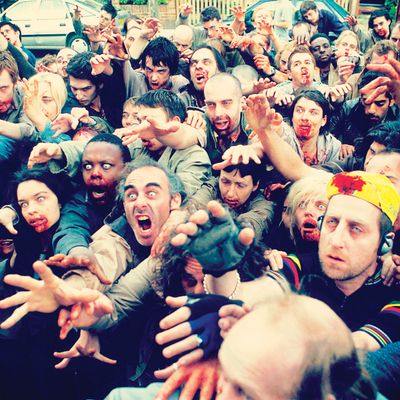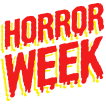Photo: Rogue Pictures/Everett Collection
So many demons are feeding on us. Just in the last few weeks, a potential plague has arrived on our shores. Hooded murderers materialize on our screens, sawing off the heads of bound captives. Cameras — some attached to hovering drones — scrutinize our comings, goings, and stayings. Electronic screens hypnotize children into inertia. Sociopathic vigilantes set upon African-Americans. Reactionary males portray unmarried females and mothers with careers as a danger to families, threatening, behind internet masks, to rape and disembowel the women who displease them. Seas rise, species die, the Earth is poised to punish humanity for its arrogance. We can’t push this stuff into our unconscious. There isn’t enough room. And it won’t stay buried. We know that soon enough there will be blood — and gore — and all the other things you can find right now in an average horror movie.
The question hangs: Why would any intelligent person who is already horrified by the news of the day want to watch horror movies?
The answer is that, unlike earnest, realistic films with Good Housekeeping Seals of approval, horror movies — with their sadism, unapologetic sensationalism, lack of nuance, and avid gratification of pathological impulses — offer sharper, more acute versions of our worst-case scenarios, brilliant metaphors for what haunts us:
Somebody’s stalking — and eager to torture — us. The most successful horror series of all time, the ne plus ultra of torture porn, is Saw. (Ten years old, it’s getting a one-week Halloween theatrical rerelease.) Its torturer/executioner, Jigsaw (Tobin Bell), presents himself as an all-seeing moral avenger. Does he conjure up fears of fundamentalist terrorism or a torturing totalitarian government? Both, actually.
Terminally ill, festering, glued to video screens that let him watch every wracking contortion of his victims, he punishes decadent, lazy Americans who take their precious lives for granted — by, say, abusing drugs. In settings of industrial decay amid raw sewage, they awake to find themselves in Rube Goldberg contraptions, forced to choose between their lives and others’. The game is rigged, and few “players” win. The thing is, though, our sympathies are muddled, the moral equations unsolvable. Just because we empathize with victims who are being slowly flayed/shredded/disemboweled, it doesn’t mean we like them — some are even disciples of Jigsaw’s who’ve lost their own compasses. So we identify with both the tortured and the torturer — and groove on the general nihilism.
The devil is technologically savvy. He or his representatives can be anywhere and everywhere. They can also screw with our technology, as in Oculus, in which nothing we see on monitors is necessarily real. The NSA could take a page from Old Scratch — or, for that matter, Jigsaw.
Our technology doesn’t help us. In fact, it makes things worse. Video in The Ring and its successors is a great demon-deliverer — it softens us up. On a stylistic level, the subjective camerawork of The Blair Witch Project and its many descendants — among them Paranormal Activity — takes away our peripheral vision and radically constricts our perspective. Listening to bumps in the night and crackles in the woods, spotting vague shadows amid trees or at the end of dark corridors, we’re reminded that nothing is scarier than nothing. Vérité documentary realism is the new gothic: It makes you doubt the efficacy of even the best investigative journalism.
Zombies are awful, but people might be worse. Plague-bearing zombies — marauding Ebola carriers? — remain the harbingers of social collapse, forcing humans to become survivalists and create new, crude hierarchies of power. Right-wingers can view them as alien invaders (seal the Mexican border!) who require a paramilitary response, as they are not just infectious but also great fun to shoot, bludgeon, and decapitate. Liberals like George Romero, who, in Night of the Living Dead, invented the modern zombie cannibal, reserve their truest horror for that paramilitary impulse and even cast zombies in the role of the disenfranchised underclass. Satirists like the Brits Edgar Wright and Simon Pegg in Shaun of the Dead use zombies to illuminate a species of English middle-class complacency. Zombies are very versatile: You can project on them what you will.
Home—representing both our actual houses (private property!) and America—can’t protect us. Here is 9/11 in its purest form. In The Strangers, You’re Next, and especially Michael Haneke’s English-language version of Funny Games, American upper-middle-class families learn that safety is an illusion. (Haneke punishes moviegoers, too, for assuming the victims will have their revenge.)
The invaders can be us, too. In the decidedly left-wing The Purge, suburban home-security mogul Ethan Hawke — who got rich keeping the upper-middle class safe from the underclass — gets an ironic comeuppance when he’s compelled to protect a black man from a mob of men and women permitted to hunt humans one night a year. (This national ritual of killing is supposed to be cathartic, but catharsis is an old-fashioned concept that has never taken. Any species that needs this much catharsis must have an endless reservoir of poison.)
Turistas and Eli Roth’s Hostel demonstrate how the rest of the world does not like Americans, in the first case by harvesting our organs (the South American surgeon simultaneously removes a kidney and holds forth on our history of colonialism), in the second by kidnapping our youngest and most vulnerable for evisceration by rich foreigners. As usual, Americans prefer to see foreigners — even in their own countries — as the invaders who threaten our way of life.
We’re killing the planet, which is taking its revenge. An oldie but goody — even goodier now — is the monster that embodies the recklessness and arrogance of technology. The wrenching Korean ecohorror film The Host shows the view of us from abroad, painting a dire picture of an American military-industrial complex that creates monsters with its effluvium, violates civil rights, and ultimately destroys families.
Some people are afraid that single women/working mothers are a threat to the integrity of the family while others are afraid of the people who are afraid that single women … etc. This often reactionary, misogynistic genre is in sync with Republicans’ ongoing war on women and their reproductive rights. For religious conservatives, the moral exemplar is Bella in the Mormon-ish Twilight, the pro-abstinence body-horror saga in which surrendering to sexual urges will get a gal ripped to shreds.
But the focus of most feminist-backlash horror movies is motherhood. Mama comes down to whether its punk-rocker protagonist (Jessica Chastain) will selfishly desert two orphans in thrall to a rabidly maternal ghost or discover her own maternal instincts and thereby save them. The Conjuring — superbly staged by James Wan (Saw) to make what’s just outside the frame irrationally terrifying — is a prime specimen of the reactionary exorcism subgenre. Here we learn that the victims of the Salem witch trials actually were witches, one of whom killed her own child to endear herself to Satan and now seeks to destroy an entire family. She will do this by possessing the weakest-willed member — the mom, natch — who then needs every tool in the Catholic Church’s arsenal to keep from butchering her own children.
Women, though, have the potential to upend the horror genre, historically controlled by the male gaze. Jennifer Kent’s terrific Aussie ghost picture The Babadook (to be released in the U.S. in late November) explores the dark side of motherhood with more empathy. The demon is clearly a metaphor, rising up from the unconscious of a single mom (Essie Davis) who on some level despises her oddball, unmanageable son. She doesn’t use the church to exorcise the Babadook, though. It’s touch and go, but she proves capable — like the vast majority of mothers — of acknowledging her resentment yet keeping it at bay.
Identical twins Sylvia and Jen Soska are rousingly audacious in American Mary, in which their lovably horrible med-student heroine (Katharine Isabelle, of the female-werewolf classic Ginger Snaps) takes surgical revenge on a rapist and then sets up shop as a good surgeon for (mostly) women who want to make radical changes to their bodies. The takeaway? Freedom of choice is scary, but subjugation results in a deeper madness.
Happy endings are impossible. We used to expect them in the days when heroes were counted on to triumph over evil. But that’s the exception nowadays. One reason you can’t keep a good demon down, of course, is that if you could, there’d be no “franchises.” But it goes deeper than Hollywood profiteering. Most of us have come to doubt that the door to hell — however you define hell — can be closed.
Is our appetite for horror greater than ever because we sense the beginning of the end of how we live now? I think so. We don’t know if it will come in the form of a plague, an ecocatastrophe, a religious war, a totalitarian crackdown, or an imperative to eat or be eaten. But while many millions watch “reality TV,” there’s a deeper, realer reality right here, in our most disreputable genre, where we feed on the demons that feed on us.
*This articles appears in the October 20, 2014 issue of New York Magazine.
Why We Need Horror Movies Now More Than Ever




